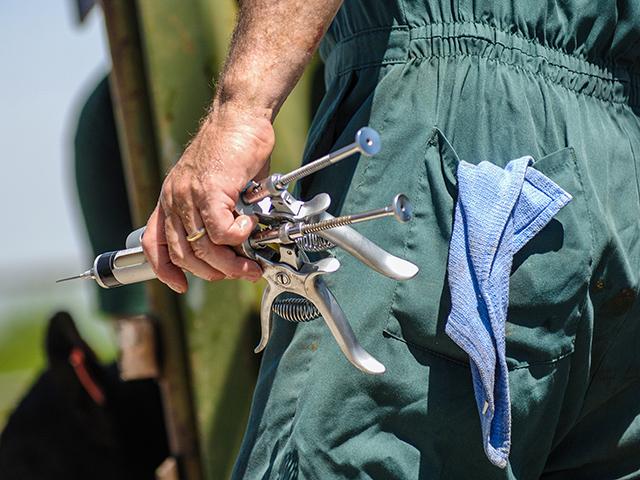Ask the Vet
New Restrictions Coming on Antimicrobial Use
READER: I heard at the feed store recently that they won't be able to sell antibiotics anymore. Is this true?
DR. McMILLAN : The Food and Drug Administration (FDA) has been concerned about antimicrobial resistance, especially with regard to those antimicrobials considered medically significant to human health. You may recall the veterinary feed directive (VFD) issued earlier that only allows antibiotics to be added to livestock feed or minerals under veterinarian guidance. The next step will be to remove over-the-counter access to many antibiotics, which goes into effect June 11, 2023.
Most antimicrobials and many other drugs used by livestock producers have a label that states: "Caution: Federal law restricts this drug to use by or on the order of a licensed veterinarian." After June 11, this statement will be on most over-the-counter antibiotics. What this means, simply put, is that you will need a prescription from a veterinarian to purchase them.
The following are expected to be affected:
-- oxytetracyclines: injectables and boluses including LA-200, Noromycin 300, Terramycin scours tablets and others
-- penicillin: injectables and mastitis tubes, including penicillin G procaine, penicillin G benzathine
P[L1] D[0x0] M[300x250] OOP[F] ADUNIT[] T[]
-- sulfa antimicrobials: injectables, powders, boluses and liquids including Albon, Sustain III Calf and Cattle Boluses, Di-Methox 40%, SulfaMed 40% sulfamethoxine, sulfamethazine, sulfadimethoxine
-- tylosin: including Tylan 50, Tylan 200
-- cephapirin, cephapirin benzathine: mastitis tubes including ToDAY, ToMORROW.
These products will still be available, but they will require a prescription. For a veterinarian to write a prescription, a veterinarian-client-patient relationship (VCPR) must exist. A VCPR requires several things under the law, including: (1) the veterinarian assumes responsibility for the animal's health; (2) the client (owner) agrees to comply with the veterinarian's instructions; (3) the veterinarian has sufficient knowledge of the animal(s) to make a general diagnosis; (4) the veterinarian assumes responsibility for follow-up care, including adverse reactions and/or treatment failures; (5) the veterinarian maintains patient records.
This does not mean you will be required to buy antibiotics only from your veterinarian. You will still be able to order them online, by telephone or at local farm stores if those outlets elect to continue to stock them. Antiparasitic products, nutritional supplements, prebiotics and topical nonantibiotic treatments will not be affected and will continue to be available.
READER: My nephew lives next door to us and is worried that if my cows get into the lot with his dairy cow, she could contract Johne's Disease from them. Is this something we need to be worried about?
DR. McMILLAN : I think it is unlikely but not impossible for this to happen. Johne's has traditionally been thought of as a dairy disease, but it's probably far more prevalent in beef cows than we know. There are more common diseases than Johne's in the beef herd, but few of them are as challenging and difficult to eliminate.
Johne's is caused by the bacterium Mycobacterium avium subspecies paratuberculosis. Infection most commonly occurs around birth or when calves are very young. Sources include colostrum of infected cows, contaminated milk, sucking and nursing contaminated udders, or sucking or licking on any other contaminated surface. Johne's can also be transmitted in utero. Older animals can become infected, especially if they are held in unsanitary, wet areas where manure has built up.
Infected cattle initially show signs of diarrhea and weight loss, but they still have good appetites. Early in the disease, there is no shedding of bacteria, and blood tests and fecal cultures will be negative. Testing can be challenging because of a long incubation period between infection and clinical signs of two to five years. There is a second phase where animals shed the virus and can infect other cattle, but show no clinical signs. The bacteria can survive in soil up to 18 months.
There is no treatment for Johne's. Infected animals waste away and die. If you have an animal with signs consistent with Johne's, it's important to get it tested by your veterinarian as soon as possible. If Johne's is ever diagnosed, a herd-testing program and strong biosecurity measures need to be implemented under the guidance of your herd veterinarian.
**
-- Please contact your veterinarian with questions pertaining to the health of your herd. Every operation is unique, and the information in this column does not pertain to all situations. This is not intended as medical advice but is purely for informational purposes.
-- Write Dr. Ken McMillan at Ask The Vet, 2204 Lakeshore Dr., Suite 415, Birmingham, AL 35209, or email vet@progressivefarmer.com
[PF_0423]
(c) Copyright 2023 DTN, LLC. All rights reserved.




